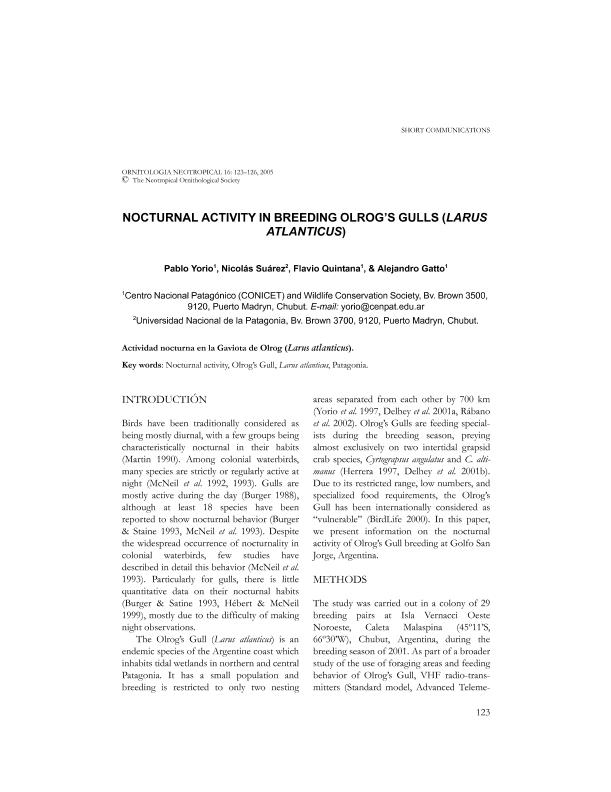Artículo
Actividad nocturna en la Gaviota de Olrog (Larus atlanticus)
Título:
Nocturnal activity in breeding olrogs gulls (Larus atlanticus)
Fecha de publicación:
12/2005
Editorial:
Neotropical Ornithological Society
Revista:
Ornitología Neotropical
ISSN:
1075-4377
Idioma:
Inglés
Tipo de recurso:
Artículo publicado
Clasificación temática:
Resumen
Birds have been traditionally considered as being mostly diurnal, with a few groups being characteristically nocturnal in their habits (Martin 1990). Among colonial waterbirds, many species are strictly or regularly active at night (McNeil et al. 1992, 1993). Gulls are mostly active during the day (Burger 1988), although at least 18 species have been reported to show nocturnal behavior (Burger & Staine 1993, McNeil et al. 1993). Despite the widespread occurrence of nocturnality in colonial waterbirds, few studies have described in detail this behavior (McNeil et al. 1993). Particularly for gulls, there is little quantitative data on their nocturnal habits (Burger & Satine 1993, Hébert & McNeil 1999), mostly due to the difficulty of making night observations. The Olrog’s Gull (Larus atlanticus) is an endemic species of the Argentine coast which inhabits tidal wetlands in northern and central Patagonia. It has a small population and breeding is restricted to only two nesting areas separated from each other by 700 km (Yorio et al. 1997, Delhey et al. 2001a, Rábano et al. 2002). Olrog’s Gulls are feeding specialists during the breeding season, preying almost exclusively on two intertidal grapsid crab species, Cyrtograpsus angulatus and C. altimanus (Herrera 1997, Delhey et al. 2001b). Due to its restricted range, low numbers, and specialized food requirements, the Olrog’s Gull has been internationally considered as “vulnerable” (BirdLife 2000). In this paper, we present information on the nocturnal activity of Olrog’s Gull breeding at Golfo San Jorge, Argentina.
Palabras clave:
Nocturnal feeding
,
Olrog's Gull
Archivos asociados
Licencia
Identificadores
Colecciones
Articulos(CCT-CENPAT)
Articulos de CTRO.CIENTIFICO TECNOL.CONICET - CENPAT
Articulos de CTRO.CIENTIFICO TECNOL.CONICET - CENPAT
Citación
Yorio, Pablo Martin; Suarez, Nicolas Marcelo; Quintana, Flavio Roberto; Gatto, Alejandro Javier; Actividad nocturna en la Gaviota de Olrog (Larus atlanticus); Neotropical Ornithological Society; Ornitología Neotropical; 16; 12-2005; 123-126
Compartir




